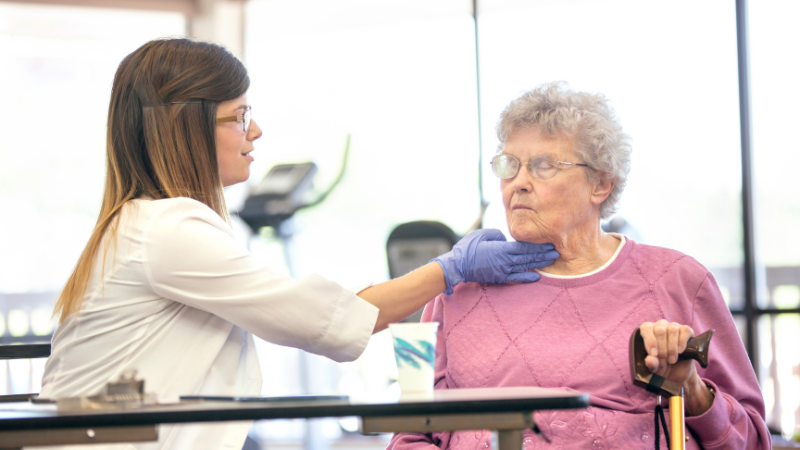This post is for informational purposes only and should not be used in place of the advice of a medical professional.
As we age, our bodies undergo numerous changes, some of which can affect our ability to perform everyday tasks we once took for granted. One such task is swallowing. While swallowing may seem like a simple and automatic process, for many elderly adults, it can become increasingly difficult and even dangerous. In this blog post, we’ll explore the reasons why some elderly adults have trouble swallowing, also known as dysphagia. From age-related physiological changes to underlying health conditions, understanding the factors contributing to swallowing difficulties is crucial for effective management and improved quality of life for seniors.
KEY TAKEAWAYS:
- Difficulty swallowing is common among elderly adults and could be exacerbated by neurological conditions or aging-related changes.
- Recognizing the signs of dysphagia and seeking the guidance of healthcare providers is essential for managing and treating this condition.
- Speech therapists and speech pathologists play a pivotal role in working with dysphagia patients to adapt their eating habits and maintain their overall health.
Video: Why Do Some Elderly Adults Have Trouble Swallowing?
Understanding Dysphagia in the Elderly
Dysphagia, a medical term for swallowing difficulties, often affects elderly adults and can significantly impact their quality of life. Understanding the swallowing process, the types of dysphagia, and common causes is critical for those experiencing this condition or caring for someone who does.
Aging and the Swallowing Process
As you age, the muscles and nerves that assist in the swallowing process may weaken. This natural age-related change can make it more challenging for older people to swallow food effectively. Health conditions like stroke, Parkinson’s disease, Alzheimer’s disease, and amyotrophic lateral sclerosis (ALS), common in the aging population, can further complicate the ability to swallow and increase the risk of dysphagia.
Types of Dysphagia
There are two main categories:
- Oropharyngeal dysphagia: This type involves problems with the throat muscles and nerves. It’s often seen in neurological disorders such as Parkinson’s disease or after a stroke.
- Esophageal dysphagia: This pertains to the esophagus, where food might feel stuck due to an esophageal stricture, Schatzki ring, achalasia, or esophageal cancer.
Identifying the type helps healthcare providers determine the best course of treatment.
Common Causes of Swallowing Disorders
Several factors can cause or contribute to swallowing problems in elderly adults:
- Neurological conditions: Stroke, Parkinson’s disease, multiple sclerosis, and myasthenia gravis affect the nervous system, complicating the swallowing process.
- Esophageal changes: Conditions like gastroesophageal reflux disease (GERD), esophagitis, and eosinophilic esophagitis can cause inflammation and narrowing.
- Aging: Age-related changes in the strength and coordination of the esophagus and throat muscles can make it difficult for an older person to swallow.
Working with a speech-language pathologist or speech therapist is a good idea to manage or improve swallowing function and reduce the risk of complications like aspiration pneumonia or weight loss.
Symptoms and Diagnosis Of Trouble Swallowing

In addressing swallowing difficulties in elderly adults, such as oropharyngeal dysphagia or esophageal dysphagia, recognizing symptoms and obtaining a proper diagnosis are crucial steps. These practices help to reduce the risk of serious health problems, such as aspiration pneumonia and malnutrition.
Identifying Symptoms
When an older person begins experiencing trouble swallowing, it’s important to identify key dysphagia symptoms. Common signs of dysphagia include:
- Coughing or choking when eating or drinking, leading to a risk of pneumonia.
- Regurgitation of food or liquids, possibly indicating gastroesophageal reflux disease.
- Unintended weight loss due to difficulty swallowing or avoiding eating.
- Dehydration or malnutrition, as a result of reduced oral intake.
- Persistent soreness in the throat muscles or chest pain while swallowing.
- Silent aspiration, where food or liquid enters the lungs without coughing or choking, could degrade the older person’s quality of life.
If you or an elderly individual you know exhibits these symptoms, consulting a healthcare provider is a good idea to determine the underlying cause.
Diagnostic Procedures
After noting the initial symptoms, the next step is a thorough diagnosis by a doctor or speech-language pathologist. They might recommend:
- A barium swallow test (modified barium swallow) or a videofluoroscopic swallow study to visually assess how well you swallow food and liquids.
- A fiberoptic endoscopic evaluation through which a tiny camera is guided down the throat to examine swallow function.
- An esophageal manometry to measure the rhythmic muscle contractions in your esophagus and the coordination of your esophageal muscles with your swallowing process.
- An endoscopy to look into the throat and esophagus for structural abnormalities, such as esophageal cancer or inflammation due to acid reflux.
For elderly patients, identifying the right medical treatment, which can range from simple dietary changes to feeding tubes in severe cases, often starts with this comprehensive evaluation.
Management and Treatment
Effective management and treatment of swallowing difficulties in elderly adults are essential to improving their quality of life and minimizing potential health risks, such as dehydration and aspiration pneumonia.
Medical and Surgical Treatments
For those with severe swallowing disorders, medical and surgical treatments are often necessary. Healthcare professionals might recommend medications to manage underlying conditions like gastroesophageal reflux disease (GERD) that can contribute to swallowing difficulties. In cases of esophageal dysphagia, surgery may be needed to address physical obstructions or malformations, such as a diverticulum or a malfunctioning esophageal sphincter.
In certain neurological conditions like Parkinson’s disease or amyotrophic lateral sclerosis (ALS), electrical stimulation provided by speech-language pathologists can help some patients improve their swallow function. A fiberoptic endoscopic evaluation may be utilized to closely examine the swallowing process and identify the best intervention.
If oral intake remains unsafe, a feeding tube may be considered to ensure adequate nutrition and hydration. This could involve a nasogastric tube for short-term use or a more permanent gastrostomy for long-term needs, especially when risk of aspiration pneumonia is high.
Nutrition and Dietary Adjustments
Dietary modification plays a critical role in managing swallowing problems in the elderly population. Speech-language pathologists and nutritionists often collaborate to design a diet that reduces the risk of choking and aspiration while still meeting nutritional needs.
Here is a suggested approach:
- Transition to softer foods like mashed potatoes and well-cooked vegetables.
- Thinning or thickening liquids, depending on the patient’s needs, can make them safer to swallow.
- Avoiding difficult-to-swallow foods, such as popcorn and nuts, will help prevent discomfort or aspiration.
Regular oral care is crucial for removing food particles and reducing the risk of infections, thus promoting overall oral hygiene. A healthcare provider or a speech therapist can offer further information on the types of food and liquid consistencies that are good options for safe consumption. In severe cases, seeking out a swallow study from a healthcare professional can provide insights into the most beneficial dietary practices for the individual’s specific condition.
Prevention and Strategies for Care
To ensure older adults maintain their quality of life, preventive measures and supportive therapies can play an important role in care.
Preventive Measures
Oral Care: Regular oral hygiene can help prevent infections which is often caused by bacteria from the mouth being inhaled into the lungs (a condition known as aspiration pneumonia). Encourage elderly adults to brush their teeth and use mouth rinses to keep their mouths clean, reducing the risk of infections and maintaining a healthy diet.
Dry Mouth Management: Keeping the mouth moist is important for the swallowing process. If older patients suffer from dry mouth, using saliva substitutes or medications that stimulate the salivary glands may help. Staying hydrated by drinking water or sucking on ice can also alleviate dry mouth.
Swallowing Exercises: A speech-language pathologist can provide swallowing exercises to strengthen throat muscles. These exercises help some older adults to swallow food more effectively, reducing the risk of choking and aspirational problems.
Dietary Adjustments: Ensuring that the elderly population has access to good options for their diet, such as softer foods or thickened liquids, can aid in preventing dysphagia symptoms from worsening.
Supportive Therapies and Rehabilitation
Speech and Language Therapist: Engaging with a speech or language therapist can be a good idea to develop personalized strategies that address the specific swallowing problems an older person faces. This might include learning new swallowing techniques or finding different medication to alleviate symptoms.
Positioning: Teaching elderly patients the correct way to position themselves when eating – such as sitting upright during meals – can help reduce the risk of dysphagia and minimize the chance of silent aspiration, which can lead to serious health problems.
Monitoring Progress: Healthcare providers should conduct regular swallow studies to monitor the improvement or progression of the condition. This data can guide further interventions or adjustments to treatment plans.
Intervention Steps: In severe cases, medical procedures such as the insertion of a feeding tube may become necessary to maintain oral intake. However, this is typically a last resort after other strategies have been exhausted.
By adopting a multidisciplinary approach involving health care providers, elderly adults with swallowing difficulties can experience an improved ability to swallow and a better overall quality of life.
Final Thoughts
In conclusion, the issue of swallowing difficulties among the elderly is multifaceted, stemming from a combination of age-related changes, medical conditions, and lifestyle factors. While dysphagia can pose significant challenges and increase the risk of complications such as malnutrition and aspiration pneumonia, early recognition and intervention are key to managing the condition effectively.
By addressing underlying causes, implementing dietary modifications, and utilizing swallowing therapies, healthcare professionals can help elderly individuals maintain their ability to eat and drink safely. Additionally, family members and caregivers play a vital role in providing support and creating a safe eating environment for their loved ones with dysphagia. With a comprehensive understanding of the factors contributing to swallowing difficulties and a collaborative approach to care, we can empower elderly adults to enjoy a better quality of life and continue to savor the pleasures of dining well into their golden years.











